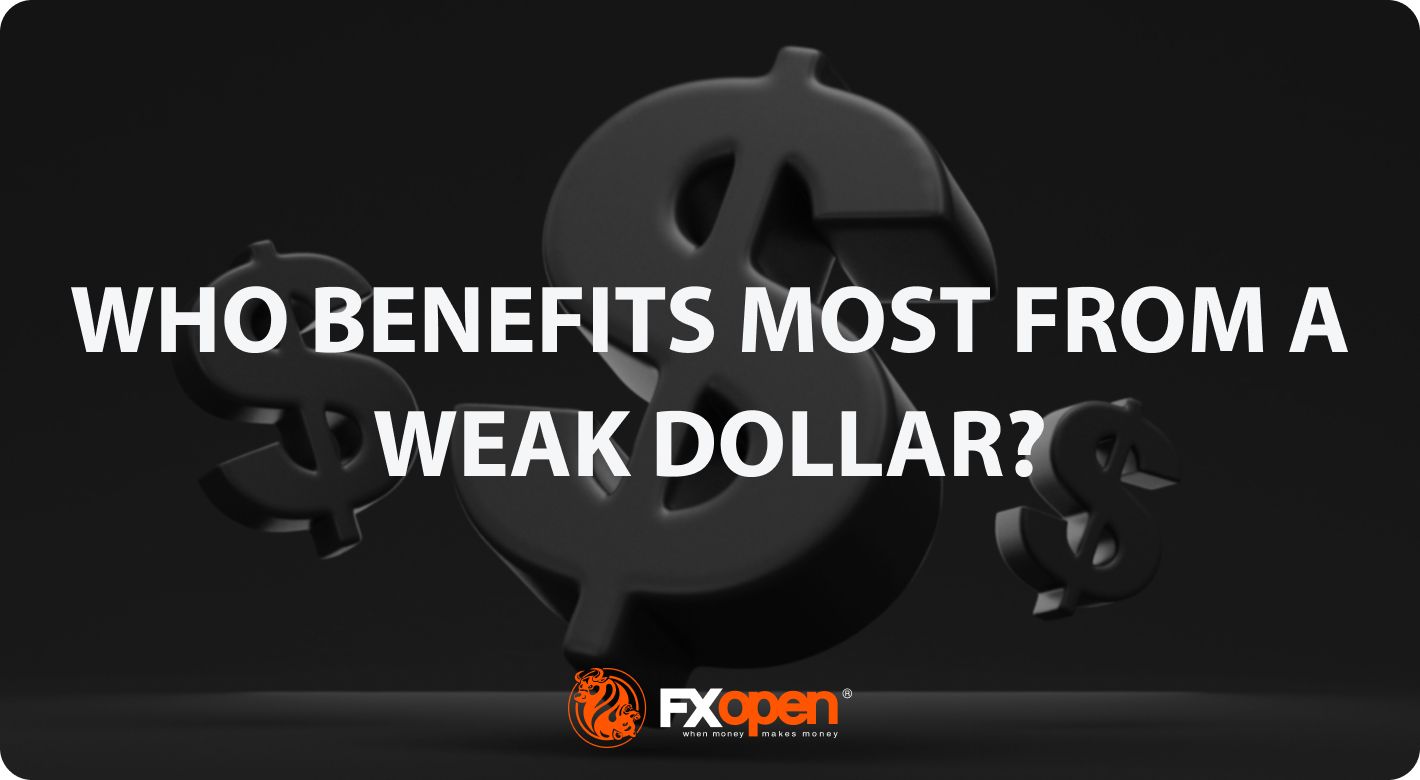FXOpen

As the global reserve currency, the performance of the US dollar (USD) against currencies from other countries is an important trading indicator. While a weak dollar might sound negative, there are financial assets that benefit when the US currency – also known as the greenback because of the colour of the banknotes – trades lower relative to other currencies.
Who benefits from a weak dollar? In this FXOpen article, we look at the definition of a strong dollar vs a weak dollar and how you can use a weak dollar in your favour.
What Is a Strong vs a Weak US Dollar?
The foreign exchange (FX) market operates like other financial markets – prices are driven by supply and demand. On the FX market, currencies are traded in pairs. What affects the performance of a strong currency vs a weak currency?
Supply consists of the currency being sold, while demand is created by the currency being bought. As in other markets, the value of one currency relative to another fluctuates constantly based on macroeconomic factors such as interest rates, inflation, central bank reserves, and trade balances. As prices fluctuate, there are opportunities to profit from trading strong and weak currencies.
For example, when consumers and businesses increase demand for US dollars, the value of the currency increases – or strengthens – relative to other currencies, allowing traders to exchange their dollars for a larger amount of another currency than before. Still, if they want to buy the USD, they will get less of it than they could previously. Conversely, when demand for the dollar falls, its value weakens relative to other currencies and traders receive a smaller amount of foreign currency than before or can buy more dollars with their native currency.
What Causes a Weak Dollar?
Several major drivers cause the USD and other currencies to weaken, including:
- Central bank policy. In the US, the Federal Reserve sets interest rate policy, which tends to drive the demand and supply of dollars. When interest rates rise, investors bring funds into the country to receive higher interest payments, increasing demand for the currency. When interest rates fall, investors look to other countries with higher rates where they can receive a larger return.
- Inflation. High inflation reduces the dollar’s purchasing power, pulling down its value against other currencies.
- Fiscal policy. US government policies on spending lower the value of the dollar if they increase supply through economic stimulus, such as during the Covid-19 pandemic.
- Economic growth. A slowdown or contraction in growth has the potential to make the US less attractive to foreign investors and traders and weigh on demand for USD.
- External central banks. Monetary policies of other central banks, e.g. the European Central Bank (ECB) or the Bank of England (BOE), can result in their currencies strengthening relative to the dollar.
- Geopolitics. The greenback is considered to be a safe-haven asset, meaning that during times of economic or geopolitical uncertainty, investors sell their higher-risk assets and buy it as a store of wealth. The dollar tends to decline when risk-on sentiment prevails.
The US Dollar Index (DXY), which measures the value of the USD against a basket of other currencies, initially fell during the Covid-19 pandemic as extended lockdowns affected the global economy but rose as restrictions eased.
However, a “strong” currency is not always better than a “weak” currency. Some groups can benefit from a weaker currency.
Who Benefits When the US Dollar Weakens?
Multinational Companies
US-based companies that generate substantial amounts of revenue in foreign currency from other countries can raise their profits, as they receive more dollars when they convert their earnings.
For example, if a US multinational company sells goods in Europe and brings in €1 million in revenue, an exchange rate of €1 to $1 would convert to $1 million. However, if the dollar weakens to $1.20 to €1, the same €1 million would be worth $1.2 million. Multinational companies that operate in multiple countries and multiple currencies can boost profits across their foreign operations.
US Exporters
US firms that export their products and services abroad benefit when the greenback falls in value as they become cheaper for foreign buyers, increasing demand. If exporters raise their prices in USD terms, these will still translate into higher prices in other currencies.
US Producers
A lower US dollar makes imports of goods and services produced in foreign countries more expensive for US consumers. This benefits US producers that compete with importers, as they can sell more domestically-manufactured goods – such as American cars – to US buyers at lower prices than imported goods.
When the US dollar weakens, the relative value of the euro rises, making a car imported from a German manufacturer more expensive for US consumers to buy as the company will need to raise the dollar price to receive the same amount of euros.
Investors
Traders and investors in assets paired with or priced in USD can benefit from better performance when the greenback weakens. And as multinational companies tend to increase their profits, their shareholders can benefit from higher stock prices and dividends. Prolonged weakness in the dollar can encourage overseas companies to acquire US companies at a discount.
In addition, investors in foreign stocks, bonds, or other assets receive higher returns when they sell the investments and exchange the proceeds for USD.
If dollar weakness prompts the Federal Reserve to reduce interest rates to stimulate the economy, borrowing costs fall for those who borrow US dollars to finance their investments.
As we have seen, a decline in the value of the dollar is not always negative. So, what does a weak dollar mean for traders? How can you trade to profit from a falling USD?
How to Trade a Weak Dollar
There are different ways traders can make money from US dollar weakness. You can trade indices, stocks, currencies, commodities, and cryptocurrencies* via CFDs on platforms such as TickTrader.
Short the US Dollar Index
You can go short on the USD by selling the US Dollar Index or an exchange-traded fund (ETF) that tracks the direction of the dollar. To short it, you open a sell position and wait for its value to decline. When closing a trade, you buy it back. The difference between the ask and bid prices is your profit.
Trade Currency Pairs
If you expect the greenback to weaken, you can trade it against another currency by buying a pair where it’s a quote currency, e.g. EUR/USD, and selling a pair in which it is a base currency, e.g. USD/JPY.
Buy Commodities
Commodities such as crude oil, metals, and coffee tend to trade in an inverse relationship to the US dollar because they are priced in USD, so a lower value of the US dollar means that commodities become cheaper for buyers, so the demand increases. You can go long on commodities such as gold when the dollar begins falling to profit from the price rise.
Buy Stocks
As US multinationals and exporters perform well when the USD weakens, investing in their stocks can generate positive returns. For example, healthcare company Johnson & Johnson’s share price has historically tended to rise on a weaker USD. The stock gained around 20% when the dollar fell during the COVID-19 pandemic, as investors anticipated that the company's foreign revenue would rise in dollar terms.
Buy Cryptocurrencies*
Cryptocurrencies* such as Bitcoin and Ethereum have emerged as an alternative asset class that you can use to potentially profit from currency fluctuations, such as hedging against a weak greenback. Cryptocurrencies* tend to gain value when the USD weakens, so you can go long when you expect it to fall and exit the position when it strengthens.
Downsides of a Weak Dollar
For traders and investors, a weak greenback can help generate profits, but there are drawbacks to an extended decline.
As the purchasing power of American consumers falls over time, they can cut spending and switch to generic brands, reducing US revenues for multinational firms and weighing on their share prices. Traders holding US dollars also have lower purchasing power when buying foreign assets, such as non-US stocks priced in other currencies.
When the value of the USD declines, volatility in financial markets can rise as investors and traders become more risk-averse.
A lower USD exchange rate also affects trade with nations with stronger currencies. It can become more attractive for other countries to adjust their currency values to gain a competitive advantage in international trade. The potential for currency manipulation can contribute to political tensions.
The Bottom Line
The use of the terms “strong” vs “weak” in describing currencies does not always equate to “good” and “bad”. There are opportunities to trade on a weak US dollar that can generate profits for traders.
It is important for traders and investors to carefully analyse the opportunities and downsides of a weak US dollar before taking a position. They should stay informed about the global economic and geopolitical developments that can affect currency values and financial markets.
If you are looking to trade assets based on the value of the USD, you can open an FXOpen account and trade forex, cryptocurrencies*, indices, stocks and commodities.
*At FXOpen UK and FXOpen AU, Cryptocurrency CFDs are only available for trading by those clients categorised as Professional clients under FCA Rules and Professional clients under ASIC Rules, respectively. They are not available for trading by Retail clients.
This article represents the opinion of the Companies operating under the FXOpen brand only. It is not to be construed as an offer, solicitation, or recommendation with respect to products and services provided by the Companies operating under the FXOpen brand, nor is it to be considered financial advice.
Stay ahead of the market!
Subscribe now to our mailing list and receive the latest market news and insights delivered directly to your inbox.








